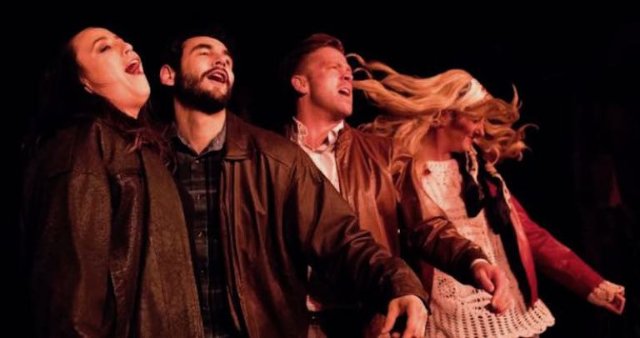Tom Stoppard's Rock and Roll
At Chicago's Artistic Home Theatre
By: Nancy Bishop - Oct 09, 2018
Tom Stoppard stirs up his personal brew of European political ideology, love, death and pop culture in his 2006 play, Rock and Roll, now on stage in a stirring production at the Artistic Home Theatre. The only Stoppard themes missing are science and technology (for which, see The Hard Problem or Arcadia, or any novel by Richard Powers, the Tom Stoppard of novelists.)
Kathy Scambiatterra directs this complex political/musical story, based on the Czech music fans and political dissidents in the years between the Prague Spring in 1968 and the Velvet Revolution of 1989.
As the play begins, it’s 1968 and Jan (Julian Hester), a graduate student, is leaving
Eleanor, suffering from advanced stage breast cancer, is a scholar of Sappho and “I had Amazons in my doctorate.” Now she is an Amazon, with one breast lost to cancer.
The brief Prague Spring is over and the Russians have invaded. Jan is interrogated about his activities at
Jan and his friend Ferdinand (Raphael Diaz) argue politics and discuss music. The Beach Boys have just played in
The years pass, with date cards printed on 12-inch record sleeves establishing each scene. In 1976, Jan, who has been imprisoned, comes home to find his records smashed and their jackets ripped. (This scene made me gasp.) At Ferdinand’s insistence, Jan does eventually sign Charter 77, a petition by Czech intellectuals to demand basic human rights. At the end of the play, it’s 1990. The Berlin Wall fell in 1989 and freedom is in the air. Esme (Kristin Collins), daughter of Max and Eleanor, goes to
The Czech band, Plastic People of the Universe, is an important element in Rock and Roll. The band played throughout this period and members were often arrested. Although their frontman died in 2001, the band continues to perform. Its last album was released in 2009. When Rock and Roll premiered in
Scambiatterra’s very strong cast features a warm, nuanced performance by Julian Hester as Jan. Max is a powerhouse bear-hug of a character as played by H.B. Ward. The proud Communist says, “I’m exactly as old as the October Revolution.” Kristin Collins carefully creates two completely differentiated characters: Eleanor, the classics scholar, dying of cancer; and later, her daughter, Esme, in love with life, music and Jan. Esme’s daughter Alice (Kayla Adams) completes the generational story.
Rock and Roll is performed with traverse or alley staging and gallery seating all around the performance space. Scenic design is by Kevin Hagan with costumes by Zachery Wagner, who should also get credit for the era-defining men’s hair styles, ranging from long and shaggy to cropped ‘80s styles. Mark Bracken is the sound designer; the music defining the era plays throughout. The walkin tracks include the Fugs’ “CIA Man” and Lou Reed’s iconic “Walk on the Wild Side.” Pink Floyd, Syd Barrett, the Fugs, Dylan and the Velvet Underground are heard throughout the play.
Stoppard acknowledges that Jan to some extent represents his own story. In an early version of the script, Jan’s character was named Tomas, Stoppard’s given name. In his introduction to his 2006 script, he also notes the influence of Milan Kundera’s The Unbearable Lightness of Being and the work and life of Vàclav Havel.
The title of Stoppard’s play is not so much a paean to my favorite music as it is a symbol of freedom itself. Political freedom, freedom from censorship and repression. Rock and roll has represented that freedom since its early days when it was banned from radio play, when parents tried to censor their children’s music choices. And most powerfully, when famous rockers took their music to sites of repression, like
Rock and Roll continues through November 18 at the Artistic Home Theatre,

